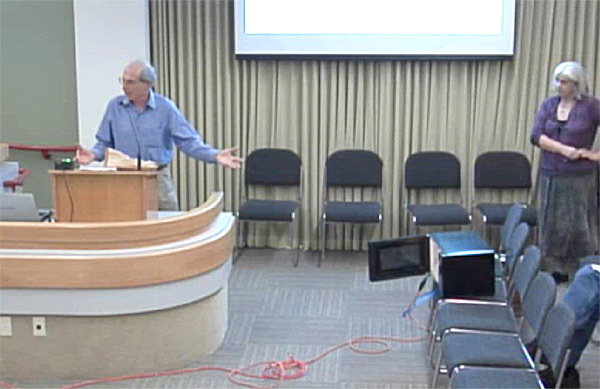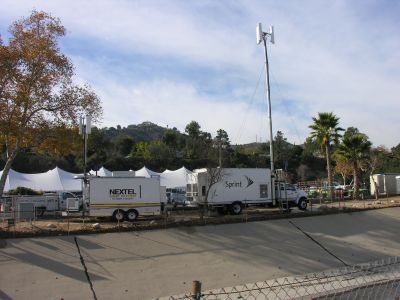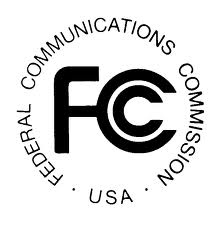
I’m verrrrrry pleased to announce that I received word a couple of hours ago that I passed the New Mexico Bar Exam, and that I’ll be admitted to that Bar on April 30th.
Did I mention that I’m verrrrrrry pleased?
Yes, I am verrrrry pleased!
Jonathan
 The FCC voted to approve T-Mobile’s application to acquire MetroPCS.
The FCC voted to approve T-Mobile’s application to acquire MetroPCS.
The next step–and perhaps the last real hurdle before the merger can be completed–is an affirmative vote of MetroPCS shareholders during a scheduled April 12 shareholders meeting.
For MetroPCS site landlords, this is a major step towards the shuttering of some 10,000 MetroPCS sites. See my story on this from last November.
Most likely, the earliest hits will occur to cell sites that presently have both MetroPCS and T-Mobile leases. The likely next round will be for MetroPCS sites located near existing T-Mobile sites. Finally, it’s quite likely that some T-Mobile sites will be shuttered where an existing collocated or nearby MetroPCS site will better suit the needs of the merged company. This may well be the case if you area a T-Mobile site Landlord currently receiving an ab0ve-market rental rate, and a suitable nearby MetroPCS site is available for joint use.
If you are presently a MetroPCS or T-Mobile site Landlord, Telecom Law Firm, P.C. is offering a no-charge, no obligation lease review to help you quantify your risk, prepare for possible site termination, and develop strategies to deal with the outgoing carrier. Just give us a call toll-free on 855-CELL SITE (855-235-5748 ) and let’s talk. You won’t be on the clock.
 Michael Friedman shared this sad news with members of SCAN NATOA today.
Michael Friedman shared this sad news with members of SCAN NATOA today.
Michael’s select words cannot begin to capture the essence of Carl, who–with his young squire, Michael–steered cable franchising on the national stage for the benefit of literally millions of Americans who will never know Carl existed, or how he touched their lives.
Carl was a gentle man, a gentleman, and a teacher.
I’m lucky to have known him.
-Jonathan
 I recently received a phone call from a very senior government rep of a very large wireless carrier. The carrier’s rep called to share his displeasure that the city I frequently work with would not administratively grant approval of what he determined to be subject to Section 6409(a) of the Middle Class Tax Relief Act as modification project of an existing cell site.
I recently received a phone call from a very senior government rep of a very large wireless carrier. The carrier’s rep called to share his displeasure that the city I frequently work with would not administratively grant approval of what he determined to be subject to Section 6409(a) of the Middle Class Tax Relief Act as modification project of an existing cell site.
Here are the general facts:
The government planner for the city involved told the carrier’s rep that he would have to submit his request following the usual application process, and that the project could be scheduled quickly for Planning Commission review. The carrier’s rep told the planner that the cty is obligated to process 6409(a) projects administratively and to then grant approval without a hearing. The carrier’s rep threatened to sue the city if the project was not administratively approved. He made the same assertion and threat to me when we talked.
I told the carrier’s rep that nowhere in 6409(a) did Congress define an administrative process–much less any specific process–that a local jurisdiction must follow when considering (1) whether a project is subject to the benefits of 6409(a) treatment, and (2) if the project is subject to 6409(a) treatment whether the project must be approved administratively. He disagreed, saying that its employer’s problem if the city has no administrative process to follow, and that 6409(a) requires it.
What I told the carrier’s rep is that where no administrative procedure exists to override a Planning Commission condition on an approved project, the condition (to bring back any site modifications to the Planning Commission) has to be followed even if the outcome may be predetermined by 6409(a). Remember, whether a project is subject to 6409(a) is a factual determination that must be made by the local government, rather than by the carrier. Given that the FCC’s guidance of last month is not binding on cities or even the Commission, and that guidance requires you ignore the plain words in the statute to follow the Commission’s recommendations, it’s obvious that facts have to be determined, and that those facts count.
Where there such a requirement in the text of 6409(a), it would simply bolster the already interesting commandeering arguments being made by local government counsel who assert that 6409(a) is unconstitutional.
Time will tell.
PS: Don’t forget that the FCC shot clock still applies to 6409(a) projects, just like it does to non-6409(a) projects.
Last night I watched a tower siting appeal hearing before the City Council of Albany, California. During the hearing, a resident came up to the speakers podium. As part of his public comment, the resident attempted to make a comparison between cell site emissions and the emissions from a microwave oven. To hammer home his point, he brought in and set up a special microwave oven in the front row of the Council Chamber.
Trying to make a point attempting to compare cell tower emissions to those from a microwave oven, the resident told the City Council that he modified the microwave oven to bypass all of the safety mechanisms. All microwave ovens come with at least two safety interlocks that immediately shut down the microwave oven if the door is opened during the cooking cycle.
The resident then proceeded to make his point by operating the microwave oven by cooking what he identified as a grilled cheese sandwich–with the microwave door open and the microwave cavity pointed at the City Council and staff.
 (Screen capture from KALB TV at 0:57:47 into the meeting)
(Screen capture from KALB TV at 0:57:47 into the meeting)
In my opinion, the resident’s ‘demonstration’ was a disingenuous and dangerous stunt. I have never seen such a stunt in 29 years of public service.
It is meaningless to attempt to compare the emissions from a 900 watt microwave oven emitting into a focused cavity resting on a chair in a meeting hall with a cell site professionally engineered to comply with federal standards (this is the disingenuous part).
While the microwave emissions may not (or may, for that matter) have exceeded the FCC’s/FDA’s standard beyond a measurable distance, no inquiry was made by the resident as to whether anyone nearby was using a pacemaker (this is the dangerous part).
Moreover, the use of an electrical extension cord to power an appliance (and to do so in a public meeting area) violates various electrical and other safety codes.
Had I been at the meeting in person, I would have stepped in to prevent or stop the stunt.
To pound the key points home:
Look, I’m all for the public expressing views at a public hearing. I am, in fact, a dyed-in-the-wool supporter of public participation in the government process.
Heck, I can live with the disingenuous participation part since it is still a public viewpoint, and even disingenuous public viewpoints are important in an open public debate.
What I do not support, however, are expressions of public participation in the government process in ways that are dangerous and/or illegal.
That’s my opinion on this resident’s stunt. What’s yours?
Jonathan

CTIA – THE WIRELESS ASSOCIATION® petitioned the FCC on December 21, 2012 to relax its rules regarding temporary wireless site installations, typically using “COLTS” and “COWS” (“cells on light trucks”, and “cells on wheels”). The FCC has responded by opening a proceeding to seek public comment (RM-11688).
The FCC’s current process requires certain types of public notice, which the CTIA says can prevent the wireless industry from bringing in additional call handling capacity for special events.
CTIA seeks a waiver from the public notice requirements for “temporary towers that (i) will be in use for 60 days or less, (ii) require the filing of a Form 7460-1 with the FAA, (iii) do not require marking or lighting pursuant to FAA regulations, and (iv) will be less than 200 feet [sic]” which CTIA calls in its petition “Two Month Towers.”
When are Two Month Towers needed? In its petition, the CTIA gave some examples:
There are also numerous instances where carriers need to deploy temporary towers in non-emergency situations with less than 30 days of advance notice. These events often occur with only a few days of advance notice, with carriers learning about the need for additional capacity at the last moment. These events nevertheless place significant short-term demands on the local wireless networks and require temporary facilities to address these capacity issues. For example:
- In 2011, President Obama vacationed in Martha’s Vineyard. Carriers did not receive sufficient advance notice of the vacation and had to quickly deploy temporary facilities to accommodate the increased capacity necessitated by the influx of press personnel and additional tourists;
- States and localities often hold ticker-tape parades to celebrate their teams’ sports championships. Carriers do not have advance notice regarding teams that will win championships and the parades usually are held shortly after the championship game;
- During presidential campaigns, candidates made stops in various towns and carriers receive less than 30 days notice due, in part, to security concerns. Once carriers learn of planned campaign stops, they mobilize to deploy temporary facilities. The lack of 30 days notice would preclude the deployment of these temporary facilities;
CTIA’s petition provided other examples of requests for temporary sites that had to be deployed could not meet the 30-day notice rule. The petition did not say how those sites were deployed without complying with the FCC’s present 30-day notice requirement, but I digress.
If you’d like to read the CTIA’s petition, CLICK HERE. To read the FCC’s request for comments on CTIA’s petition, CLICK HERE. Comments are due on February 25, 2013, with reply comments due on March 12, 2013. To search for filed comments, CLICK HERE.
 Yesterday, January 25th, the FCC released a public notice titled, “WIRELESS TELECOMMUNICATIONS BUREAU OFFERS GUIDANCE ON INTERPRETATION OF SECTION 6409(a) OF THE MIDDLE CLASS TAX RELIEF AND JOB CREATION ACT OF 2012” (DA 12-2047).
Yesterday, January 25th, the FCC released a public notice titled, “WIRELESS TELECOMMUNICATIONS BUREAU OFFERS GUIDANCE ON INTERPRETATION OF SECTION 6409(a) OF THE MIDDLE CLASS TAX RELIEF AND JOB CREATION ACT OF 2012” (DA 12-2047).
As an aside, I note that the Commission did not consult with its own Intergovernmental Advisory Committee, much less advise them of the release of this Guidance in advance.
The Commission crafted its Section 6409(a) Guidance to provide the public its own view of how state and local governments should interpret the following self-created questions:
I’ll let you read the Guidance for yourself (see link below) to learn the Commission’s thoughts in response to its four questions. I’m not going to get into my specific thoughts about the Guidance other than to say that it is flawed and overreaching in most areas covered. The only bright light is that the Commission did recognize that carriers are not exempt or excused from following the state or local government application process for collocations covered by Section 6409(a).
Importantly, however, there is about a 103% certainty that wireless carrier representatives will show up to local governments toting a copy of the Guidance misrepresenting it as the way that 6409(a) must be read and understood by those governments. That will be factually incorrect, but its tough for planners at “the counter” to critically evaluate a document bearing the FCC seal. That critical evaluation and the inevitable challenges to the Guidance will be a job for attorneys and stakeholder organizations like NATOA.
At the end, the Commission’s Guidance is advisory only. Given the fundamental omissions and differences in Section 6409(a) (some of which are acknowledged by the Commission), Section 6409(a) remains a moving target, as does compliance with that moving target.
Click here to read the FCC’s Guidance on 6409(a)
AB 1536, which is effective today, January 1, 2013, changes California law to allow some texting while driving. Texting is allowed if your phone can be used by voice commands, such as using Apple’s iPhone Siri feature. She has powerful friends in Sacramento!
It will be interesting to see how this change to the prior law, which made texting while driving illegal, plays out.
Here is the test of the newly revised California vehicular texting law, effective today:
 THE PEOPLE OF THE STATE OF CALIFORNIA DO ENACT AS FOLLOWS:
THE PEOPLE OF THE STATE OF CALIFORNIA DO ENACT AS FOLLOWS:
SECTION 1. Section 23123.5 of the Vehicle Code is amended to read: 23123.5.
(a) A person shall not drive a motor vehicle while using an electronic wireless communications device to write, send, or read a text-based communication, unless the electronic wireless communications device is specifically designed and configured to allow voice-operated and hands-free operation to dictate, send, or listen to a text-based communication, and it is used in that manner while driving.
(b) As used in this section “write, send, or read a text-based communication” means using an electronic wireless communications device to manually communicate with any person using a text-based communication, including, but not limited to, communications referred to as a text message, instant message, or electronic mail.
(c) For purposes of this section, a person shall not be deemed to be writing, reading, or sending a text-based communication if the person reads, selects, or enters a telephone number or name in an electronic wireless communications device for the purpose of making or receiving a telephone call or if a person otherwise activates or deactivates a feature or function on an electronic wireless communications device.
(d) A violation of this section is an infraction punishable by a base fine of twenty dollars ($20) for a first offense and fifty dollars ($50) for each subsequent offense.
(e) This section does not apply to an emergency services professional using an electronic wireless communications device while operating an authorized emergency vehicle, as defined in Section 165, in the course and scope of his or her duties.
…their merger is approved by the federal government. This represents about 87% of all of the MetroPCS sites, excluding the DAS nodes. MetroPCS estimates that this will save them…really, T-Mobile…about $7B in site lease costs.
 Doing some back-of-the-napkin calculations based on a 25 year average term, a $7B savings would work out to average blended going forward monthly rent of $2,333. Over a 30 years term, monthly rent drops out to about $1,944, blended. Frankly, this that sounds high to me, but perhaps my napkin is a bit wet.
Doing some back-of-the-napkin calculations based on a 25 year average term, a $7B savings would work out to average blended going forward monthly rent of $2,333. Over a 30 years term, monthly rent drops out to about $1,944, blended. Frankly, this that sounds high to me, but perhaps my napkin is a bit wet.
MetroPCS’s announcement also alludes to an interesting technology conclusion: T-Mobile is satisfied with the bulk of its existing coverage from its existing sites. It must believe that it can take MetroPCS’s bandwidth and redeploy it from T-Mobile’s existing sites, most likely using upgraded base transceiver/telecommunications station (“BTS”) cabinets. For the non-technical of you reading this, this means that the MetroPCS acquisition is a bandwidth/capacity play; not a coverage play.
Without the passage of Section 6409(a), this pending deal might not have happened. We’ll see how the constitutional challenges to Section 6409(a) impact this deal.
MetroPCS’s announcement is yet another cautionary tale to potential wireless site landlords…
Wireless site landlords are most often bound to lease for 25 to 30 years with few, if any, real ‘outs.’ Conversely, the typical tenant ‘outs’ in a lease make their side of the deal really only a 30 day guarantee (if you’re lucky you might get 6 months).
For those of you who are considering entering into new leases, you are best served to carefully evaluate whether a 30 year v. 30 day commitment makes real sense. If not, then keep negotiating. If you are a wireless site landlord with a tenant requesting a renewal, extension, or modification, this is the time to negotiate a meaningful termination clause. This is what we tell our clients, and what we do for our clients.
We also tell our clients, ‘Sometimes the best deal is the one you walk away from.’
Food for thought on this Thanksgiving.
-Jonathan
SBA recently acquired Mobilitie’s tower portfolio of over 2,300 tower sites.
My friend and trusted colleague, attorney Mike Ritter of Tower Seekers has sent me a copy of an interesting (and potentially disastrous) letter being sent to tower site landlords by SBA, a tower company that acquired Mobilitie’s tower sites.
SBA (or one of its affiliates) is going after financing, and the SBA letter say, in part:
[SBA] or one of its affiliates is obtaining financing (the “Loan”) from a lender (together with its successors and assigns, the “Lender”), and will be pledging its interest in the Lease as collateral for the Loan and the Lender is also requesting confirmation of certain matters regarding the Lease.
In other words, SBA is going to take your wireless site lease and pledge it to secure a bank loan.
The next part of the letter asks the landlord to confirm certain facts about the existence and status of the cell site lease. This is a request for the landlord to execute what is called an ‘Estoppel Certificate.’ The landlord is being requested to legally certify that the facts stated in the letter are true and correct, and the lender can rely on those facts when making its loan to SBA. Commonly, there’s nothing wrong with such a request as long as the facts stated are entirely correct.
Once signed, however, the landlord is legally estopped (barred) from later claiming that some problem with the lease existed at or prior to the date he or she signed the Estoppel Certificate. If there’s some undiscovered problem, but the landlord signs the Estoppel Certificate, then he or she can be giving up very valuable lease enforcement rights. This is why it is critical for landlords to be exceptionally careful in ascertaining the accuracy of the facts before executing the Estoppal Certificate. In some cases, you (or more likely your attorney) will want or need change the language of the Estoppel Certificate before signing it, if it can be truthfully signed at all.
For example, in a current matter I’m handling for one of my cell tower site landlord clients, a tower company — not SBA — sent a written request to my client asking that he execute an Estoppel Certificate. The tower company even offered to pay $500 for the landlord’s execution of the Estoppel Certificate. At that time, however, the tower company was in serious Rent arrears by many thousands of dollars. Had my client signed the the Estoppel Certificate before I reviewed it, he would have wiped out major claim for the overdue rent for the token payment of $500. That’s a great business deal, but only for the tower company.
Now back to SBA and its zinger: Not only does the SBA letter serve as an Estoppel Certificate, there’s also a lot of added language that is intended to be a legally binding formal amendment to the underlying lease. The amendment would have the landlord give up tremendously valuable legal rights. Here are the Zinger sections from the SBA letter, followed by my translations from Legalese to English:
(e) If Lender exercises any rights of Tenant under the Lease, including the right to exercise any renewal option(s) or purchase option(s) set forth in the Lease, you agree to accept such exercise of rights by Lender as if same had been exercised by Tenant, and Tenant, by signing below, confirms its agreement with this provision.
Plain English Translation: If your lease requires that you receive notice of the tenant extending its term, you agree to accept that notice from the third party lender.
(f) If there is a monetary default by Tenant under the Lease, you will accept the cure thereof by Lender within fifteen (15) days after the expiration of any grace period provided to Tenant under the Lease to cure such default, prior to terminating the Lease. If there is a non-monetary default by Tenant under the Lease, Landlord will accept the cure thereof by lender within thirty (30) days after the expiration of any grace period provided to Tenant under the Lease to cure such default, prior to terminating the Lease.
Plain English Translation:If your tenant stops paying you and you are about to terminate the lease, the lender is given additional time to beyond the grace period to pay you. This negatively affects your rights to terminate the lease for non-payment, and to then enter into a new agreement with better terms…for you.
(g) The Lease may not be amended in any respect which would be reasonably likely to have a material adverse effect on Lender’s interest therein or surrendered, terminated or cancelled, without the prior written consent of Lender.
Plain English Translation: If you negotiate a lease modification in good faith with your tenant, the lender need only claim that amendment would likely have some negative impact on the lender to then nullify the amendment.
(h) If the Lease is terminated as result of a Tenant default or is rejected in any bankruptcy proceeding, you will enter into a new lease with Lender or its designee on the same terms as the Lease within 15 days of Lender’s request made within 30 days of notice of such termination or rejection, provided Lender pays all past due amounts under the Lease. However, this is not applicable to normal expirations of the lease term.
Plain English Translation: If the lease is terminated for virtually any reason, including bankruptcy of your tenant, you have no choice but to enter into a new lease on the same (perhaps lousy) terms of the terminated Lease. You lose virtually all rights to end your lease because of some bad act of the tenant…the most likely result is that the lender says, ‘do over’ and poof: A new lease on the same old terms as the one that you just terminated.
This letter shall be binding on Landlord and Tenant and their respective successors and assigns and shall inure to the benefit of Lender. Tenant shall have the right to record this letter and it shall serve a as a memorandum of the Lease. Tenant shall have the right to record this letter and this recorded letter shall be deemed to provide notice of all of terms of the Lease.
Plain English Translation: This letter is NOT ONLY an Estoppel Certificate, it’s a binding amendment to your lease adding terms that are not very good for you as the landlord, but REALLY good for the lender and the tenant.
Please indicate your agreement to the foregoing matters by countersigning this letter in the space provided in the presence of two witnesses and a notary public and returning an original, countersigned, witnessed and notarized copy of this letter to Tenant in the enclosed prepaid Federal Express envelope.
Plain English Translation: Sign on the dotted line in front of a couple of witnesses and we’ll spring for the cost of returning the stuff to us. Oh boy!
If you are a tower site landlord and get one of these letters, I strongly urge you to talk with your attorney before you even think about signing it. As your attorney will likely tell you, you should not agree to a modification of your lease without knowing all of the upsides and downsides of the modification, and in some cases trying to balance the downsides with new benefits.
Now you know my opinions on regarding letters like the one being sent out by SBA. Be very careful.